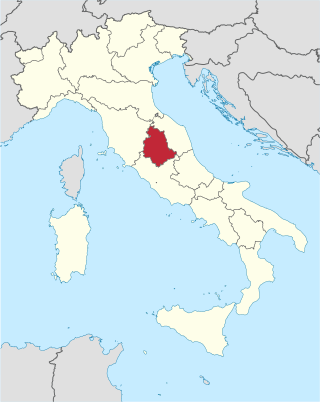
Umbria is a region of central Italy. It includes Lake Trasimeno and Marmore Falls, and is crossed by the river Tiber. It is the only landlocked region on the Apennine Peninsula. The regional capital is Perugia.
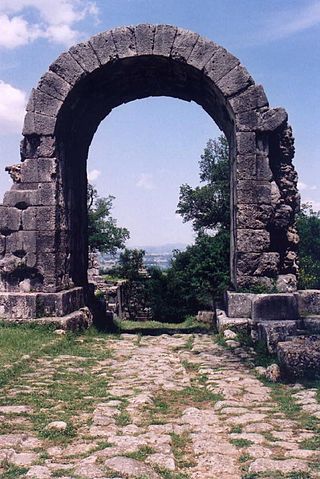
The Via Flaminia or Flaminian Way was an ancient Roman road leading from Rome over the Apennine Mountains to Ariminum (Rimini) on the coast of the Adriatic Sea, and due to the ruggedness of the mountains was the major option the Romans had for travel between Etruria, Latium, Campania, and the Po Valley. The section running through northern Rome is where Constantine the Great had his famous vision of the Chi Rho, leading to his conversion to Christianity and the Christianization of the Roman Empire.

The Province of Terni is the smaller of the two provinces in the Umbria region of Italy, comprising one-third of both the area and population of the region. Its capital is the city of Terni. The province came into being in 1927, when it was carved out of the original unitary province of Umbria.
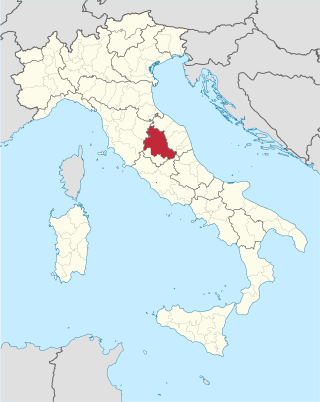
The Province of Perugia is the larger of the two provinces in the Umbria region of Italy, comprising two-thirds of both the area and population of the region. Its capital is the city of Perugia. The province covered all of Umbria until 1927, when the province of Terni was carved out of its southern third. The province of Perugia has an area of 6,334 km² covering two-thirds of Umbria, and a total population of about 660,000. There are 59 comunes in the province. The province has numerous tourist attractions, especially artistic and historical ones, and is home to the Lake Trasimeno, the largest lake of Central Italy. It is historically the ancestral origin of the Umbri, while later it was a Roman province and then part of the Papal States until the late 19th century.

Trevi is an ancient town and comune (municipality) in Umbria, Italy, on the lower flank of Mount Serano overlooking the wide plain of the Clitunno river system. Located in the Province of Perugia, it is 10 km (6 mi) SSE of Foligno and 20 km (12 mi) north of Spoleto. It is a member of the I Borghi più belli d'Italia association.
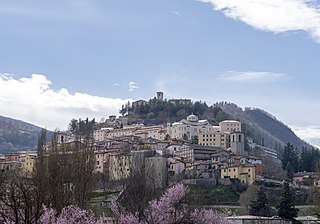
Cascia is a town and comune (municipality) of the Italian province of Perugia in a rather remote area of the mountainous southeastern corner of Umbria. It is about 21 km from Norcia on the road to Rieti in the Lazio (63 km). It is also very close to Terni.

Bettona is an ancient town and comune of Italy, in the province of Perugia in central Umbria at the northern edge of the Colli Martani range. It is 5 km (3 mi) E of Torgiano and 12 km (7 mi) SW of Assisi. It is a member of the I Borghi più belli d'Italia association. Passaggio, Colle and Cerreto are frazioni of the comune.

Carsulae is an archaeological site in the region of Umbria in central Italy. It is located approximately 4 kilometres (2.5 mi) north of San Gemini, a small comune in the province of Terni.

Amelia is a town and comune of the province of Terni, in the Umbria region of central Italy. It grew up around an ancient hill fort, known to the Romans as Ameria.

Acquasparta is a town and comune in the province of Terni. It is located on a hill above the Naia Valley and the river of the same name, facing the Monti Martani mountain range. It is a member of the I Borghi più belli d'Italia association. It also sits between two hot springs, the Amerino and the Furapane.

Ferentillo is a comune (municipality) in the Province of Terni in the Italian region Umbria, located about 60 km southeast of Perugia and about 12 km northeast of Terni. The comune, located in the valley of the Nera, is divided by the river into the burghs of Matterella and Precetto.

Montecastrilli is a comune (municipality) in the Province of Terni in the Italian region of Umbria, located about 50 km south of Perugia and about 15 km northwest of Terni.
Montecchio is a comune (municipality) in the Province of Terni in the Italian region Umbria, located about 50 km south of Perugia and about 30 km northwest of Terni.
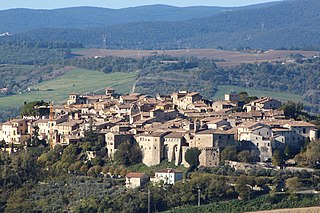
San Gemini is a comune (municipality) of c. 5,000 inhabitants in the province of Terni in the Italian region Umbria, located about 60 km south of Perugia and about 10 km northwest of Terni.

Avigliano Umbro is a comune (municipality) in the Province of Terni in the Italian region Umbria, located about 50 km south of Perugia and about 20 km northwest of Terni. As of 2011 census its population was of 2,568.

Cesi is a frazione of the Italian comune of Terni, in the province of Terni, southern Umbria, Italy. The small borgo, which retains its late-medieval aspect, set among olive groves, lies "stretched out lengthwise along a narrow contour on the slopes of M. Torre Maggiore," about 18 km north of Terni at an altitude of 437 m, one of the southernmost peaks of the Monti Martani. As of 2001 there were 682 residents.
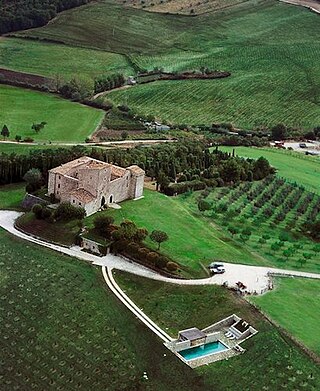
The Todi Castle is a former medieval Castle located 15 km south of the town of Todi, to the east side of the town of Collelungo, which is part of the Municipality of Baschi, near Terni, in Umbria, Italy.

Sismano, a little medieval borgo, is a frazione of the Italian commune of Avigliano Umbro, in the province of Terni. Sismano lies 13 km from Todi and 5 km from Avigliano; according to the Italian state census of 2001, Sismano has 17 inhabitants in the densely built historic center and 308 in all.

San Lorenzo in Nifili is a Romanesque-style, Roman Catholic church located near the village of Farnetta, part of the commune of Montecastrilli, in the province of Terni, region of Umbria, Italy.
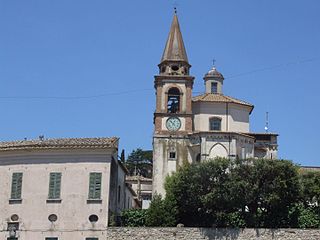
San Francesco is a gothic-style, church located in the town of Amelia, Province of Terni, region of Umbria, Italy.

























